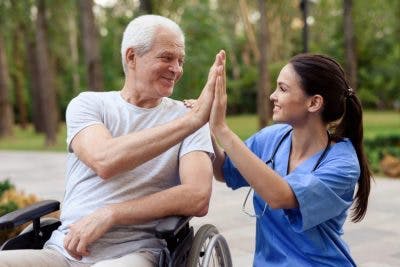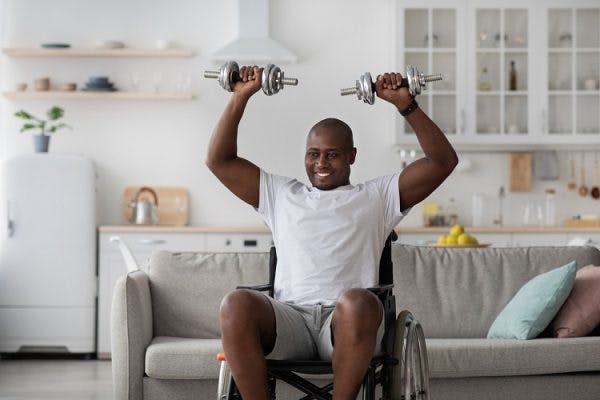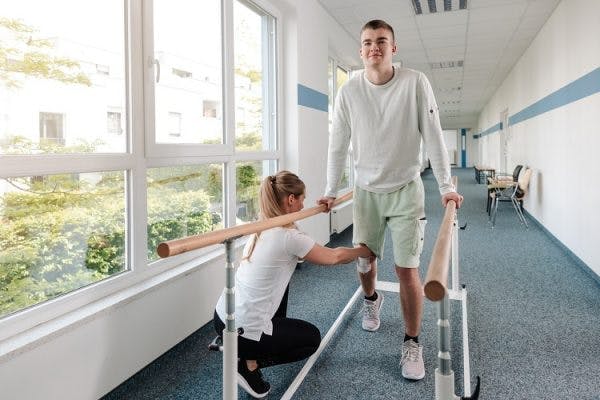About 32% of all spinal cord injuries result in a complete spinal cord injury, according to the National Spinal Cord Injury Statistical Center.
A complete spinal cord injury occurs when the spinal cord is completely severed. This results in the loss of all sensation and motor control below your level of injury. Fortunately, there is hope for recovery after a complete SCI.
To help you better understand what to expect following a complete spinal cord injury, this article will discuss:
What Causes a Complete Spinal Cord Injury?

A complete spinal cord injury occurs when all neural connections at the site of injury are affected, resulting in no spared pathways. Therefore, complete spinal cord lesions are the most severe form of SCI. They are most commonly caused by car accidents, falls, contact sports, and acts of violence. To understand why this affects movement and sensation, let’s review how the brain, spinal cord, nerves, and muscles communicate.
The spinal cord is the communication pathway that transmits messages between the brain, the peripheral nerves, and the muscles. When an individual has a complete SCI, the damage affects all neural pathways below the level of injury. Because signals are unable to travel past damaged neurons in the spinal cord, the brain cannot receive sensory signals from the body, and the body cannot receive motor signals from the brain.
As a result, only sensation and motor control at and above the level of injury are left unaffected. In contrast, all sensation and motor control below the level of injury is cut off, resulting in paralysis.
Depending on the level of injury, complete spinal cord injuries may result in quadriplegia (loss of use of all four limbs and trunk) or paraplegia (loss of use of the lower half of the body). The higher the level of injury, the more areas of the body are affected.
Can an Incomplete Spinal Cord Injury Be Mistaken for a Complete One?
Not all spinal cord injuries are complete. In fact, the majority of spinal cord injuries are considered incomplete, meaning that there are still some neural pathways left intact below the level of injury. In contrast to those with complete SCIs, individuals with incomplete SCIs retain some motor and/or sensory functions below their level of injury.
Sometimes, a complete spinal cord injury can be misdiagnosed due to spinal shock. Caused by excessive swelling immediately after an SCI, spinal shock describes the complete loss of reflexes, sensation, and muscle tone below one’s level of injury. This can result in an incomplete spinal cord injury being mistaken and misdiagnosed as a complete SCI.
Fortunately, spinal shock is a temporary condition and once inflammation begins to decrease, reflexes may gradually start to return. Spinal shock may be present for several months before it begins to subside.
As spinal shock progresses, individuals will go from experiencing low, flaccid muscle tone to hyperactive reflexes that result in high muscle tone. This drastic change from one extreme to another is generally a good indication that the neurons in the spinal cord are adapting.
Therefore, individuals with SCIs may be happily surprised to discover that their SCI is not as severe as it initially appeared.
Learn more about spinal shock after SCI »
How to Exercise with a Complete Spinal Cord Injury

Although a complete spinal cord injury results in paralysis below the level of injury, it’s essential to continue to move the entire body.
This involves continuing to exercise unaffected regions of the body and having a trained caregiver or physical/occupational therapist perform passive range of motion exercises on affected regions. Passive range of motion does not require energy exertion by the individual with paralysis. Rather, a caregiver or therapist moves the individual’s body for them.
Exercise will help individuals with complete spinal cord injuries maintain full range of motion in their joints, promote circulation, and prevent secondary complications like pressure sores and edema (swelling) from developing.
Is It Possible to Recover After a Complete Spinal Cord Injury?

While damaged neurons in the central nervous system are not capable of regeneration, there is still hope for recovery after a complete spinal cord injury. Many innovative treatments such as electrical stimulation and stem cell therapy are showing great promise for the future of complete spinal cord injury recovery. However, they still require further research and development before being widely implemented.
Rehabilitation after a complete spinal cord injury will generally focus on maximizing your functional abilities. This means learning how to use functions you do have control over to optimize your ability to care for yourself and protect affected regions of your body from further complications.
Below, we’ll discuss various management techniques for complete SCI.
1. Epidural Electrical Stimulation
Epidural electrical stimulation involves implanting a stimulator over your spine. The stimulator then emits electric currents that mimic brain signals to muscles below the site of injury. Epidural stimulation works around the spinal cord damage to activate the neurons below the level of injury and encourage movement.
For example, this study combined intensive gait training and epidural electrical stimulation on 2 individuals with complete spinal cord injuries. By the end of the 85-week period, both individuals were able to sit, stand, and walk on a treadmill with body-weight support. Although it is still being studied, the initial study results of epidural electrical stimulation are very promising, especially when combined with conventional therapies.
2. Stem Cell Therapy
Stem cells are cells that can divide infinitely and differentiate into a variety of cell types depending on their environment. This makes them ideal for promoting tissue growth and replacing damage caused by SCI.
The type of stem cells most commonly studied for SCI recovery is mesenchymal stem cells, which come from bone marrow.
This case study used a combination of bone marrow nucleated cells and mesenchymal stem cell implantations on a 15-year-old patient with complete SCI. Within 2 years, she developed improved sensations in her lower body and regained bladder, bowel, and trunk control.
While stem cell therapy still requires larger-scale experimentation, this suggests that functional recovery after a complete SCI may be possible in the future.
3. Physical Therapy
Physical therapy plays an essential role in the treatment of complete spinal cord injuries.
At physical therapy, individuals will learn how to exercise areas of the body unaffected by paralysis and how to properly perform passive range of motion exercises on affected areas. They will also learn how to continue with these exercises on their own at home (with a trained caregiver assisting as needed). Exercising will help reintroduce movement to the body to prevent stiffness, promote circulation, and reduce joint pain.
4. Occupational Therapy
Occupational therapy focuses on helping individuals with complete spinal cord injuries learn how to be functional in their day-to-day lives. An occupational therapist will assess the individual’s sensory and motor skills and determine what types of adaptive techniques they can benefit from.
This may involve learning how to use adaptive tools such as a universal cuff to help you hold onto items or a transfer bench to bathe.
5. Psychotherapy
Generally, the more severe a spinal cord injury is, the more challenging it is to cope and adapt. A psychotherapist can help provide the emotional support and guidance you need to get through this difficult time.
6. Caregiver Assistance
A complete spinal cord injury can require you to become more dependent on others. Some people don’t want to burden their loved ones with tasks like using the toilet or bathing. Instead, they find it more comfortable to hire a caregiver.
7. Joining a Support Group
Joining a support group is a great way to connect with others that understand what you’re going through. There, you can share experiences and learn more about potential effects of spinal cord injury,
A support group can also serve as a safe space where you can empower each other with positivity and helpful advice. Family members of those with complete SCIs may also find joining a support group beneficial.
8. Exoskeletons
Exoskeletons are wearable electronic devices that can help individuals with complete spinal cord injuries maximize their mobility. To facilitate movement, individuals simply shift their body weight in the direction they want to go while wearing the robotic exoskeleton.
While exoskeletons are costly and generally not covered by insurance, they enable individuals to perform movements that they otherwise may be unable to as a result of paralysis. This can improve circulation, reduce muscle atrophy, and help individuals maximize their independence.
Complete Spinal Cord Injury: Key Points
Complete spinal cord injury recovery is most effective with the support of rehabilitation specialists and targeted adaptive equipment.
Living with a motor disability may be challenging, but many individuals adapt to live their best life with complete SCI by surrounding themselves with loved ones and focusing on what they can do instead of what they can’t do.
While damage following a complete SCI is irreversible, promising research suggests that recovery may be possible in the future. In the meantime, individuals can learn how to be as functional as possible to optimize their quality of life. We hope this article helped you understand what to expect after a complete spinal cord injury.











